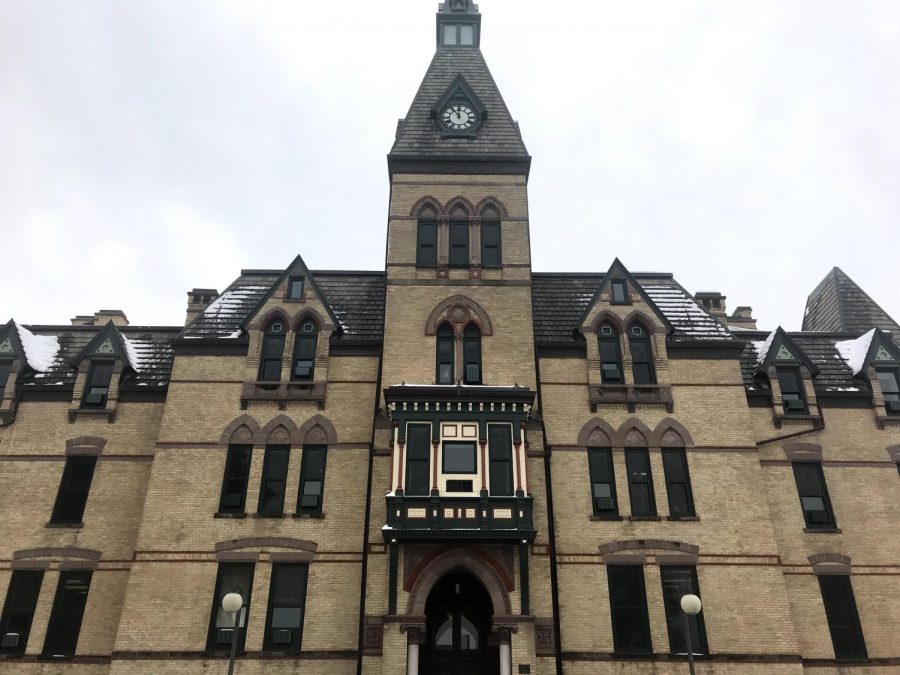Seeing smaller
The physics department has a new instrument… and it has really good eyesight.
Emily Lall
Hamline physics students get to work with a new, high tech microscope that was purchased for the department this year. Its use, however, goes beyond just the physics department, applying to various field and projects.
November 25, 2020
Physics professor Jerry Artz twiddles a joystick on a keyboard that looks more like the control panel of a Star Trek ship than anything one would find in a regular computer lab.
“You see it move? It’s all remote controlled. Isn’t that amazing?” Artz said.
He is seated next to a white box the size of a refrigerator that purrs with a strangely human repletion.
Rumors have skittered around campus about the big mysterious machine that appeared one day in Robbins Science Center. Big as it may be, its function is anything but mysterious to the people who work with it.
The machine is an environmental scanning electron microscope (ESEM), like a standard lab microscope but much bigger.
“[It is]state of the art,” Artz said.
While regular microscopes use lenses and light beams to magnify an image, scanning electron microscopes (SEMs) use a focused beam of electrons. The electrons are shot through a sample, and their trajectories are picked up by detectors inside the microscope. The result is a microscale image with a resolution of about three nanometers, explained first-year student and physics department employee Josh Sedarski.
A nanometer (one billionth of a meter) is a difficult measurement to visualize. To reach it, the diameter of a human hair would have to be split 75,000 times. 85,000 nanometers can comfortably sit side by side on the thickness of this sheet of newspaper.
This microscope is so incredibly powerful that with it, a cluster of about three atoms can be seen — and it is on Hamline’s campus.
Additionally, ESEM has a pretty significant advantage over the more standard SEM.
“A regular SEM is under very high vacuum. What happens when you’re up to this very high vacuum, is when you put in an object to magnify, the vacuum will rip off the surface of the thing you’re trying to see,” Artz said. “If you want to see the surface of something, and it’s not there – that’s a problem. An ESEM will actually introduce a small amount of humidity over the sample, and that will preserve the surface, and keep it from getting ripped off.”
SEMs require a layer of electrical coating, but, as Physics Professor Lifeng Dong explains, “With the ESEM, that means without electrical coating, and we can see the natural structure.”
The acquisition of this machine has profound implications for the physics department.
“We have a very active renewable energy department in physics because we just feel like that’s kind of the wave of the future, and we should be preparing our students to work with sustainable energy,” Artz said.
An ESEM will be incredibly helpful in the department’s work with solar cells and supercapacitors — a growing innovation in electric vehicle development.
However, the applications of a machine like this extend well beyond the domain of physics. It has expansive uses in the medical field, material sciences, virology, electronics, genetics, chemistry, forensics and even things like anthropology through soil and rock sampling.
“The ESEM is very good for the interdisciplinary, not just physics,” Dong said.
The funding for the ESEM came from $235,000 in donations from alumni. All requests for donations were under the coordination of Hamline University’s Institutional Advancement and its director Mike Tompos. The physics department got a good deal on it, too, thanks in no small part to COVID-19.
“If you’re gonna buy, now’s the time to buy,”Artz said, “It’s supply demand, you know? Nobody had money to buy, and the price came down.”
The department is now working on setting up an endowment for maintenance and upkeep.
To properly care for the microscope, the Tungsten filaments that provide the electrons need to be replaced and vacuum pumps need to be cleaned.
“It takes quite a bit of work just to maintain it,” Artz said.
This addition to Robbins Science marks a milestone that the physics department believes will be greatly beneficial to students.
“Even though they just learn how to operate one device, that gives them the mental capacity to learn other kinds of machines,”Artz said, “Being able to say ‘I worked on the Hamline environmental scanning electron microscope,’ that’s a plus. That sets them ahead of other people… We want to provide the very best education we can for our students.”

